
Andrea M. Russo
Technological innovation is always improving the future of health care. From artificial intelligence to wearable sensors to virtual reality, the opportunities for these technologies to change the future of health care are unparalleled. As a doctor that specializes in heart rhythm disorders, I have witnessed firsthand how the advancement of technology is changing the way we monitor our health. Over the past couple of years, more and more of my patients have come to the office with historical records of their heart rate. The accessibility to our own personal health data is leading to advances in access to information that impacts the medical care of our patients.
According to Pew Research Center, roughly three-quarters of Americans (77 percent) now own a smartphone. In 2016 alone, 22 million wearable units were shipped worldwide, which include brands such as Fitbit and Apple Watch. Not only is the use of wearable devices and mobile technology on the rise, but the innovation is also advancing at a rapid pace, opening up opportunities for people to play a more active role in their health care.
Detection of heart rhythm disorders
We’ve moved beyond wearable devices and mobile technology that simply track our fitness goals and sleep patterns. They can now monitor our heart rates and rhythm, which means people can keep a closer watch on their heart health than ever before. We can look at data from these devices or apps to screen for irregular heart rates that could indicate something serious like atrial fibrillation (AFib). AFib is a common abnormal heart rhythm that affects more than 2.7 million Americans, and it is estimated that 12 to 16 million Americans will have AFib by 2050. AFib also increases the risk of stroke fivefold.
Symptoms can include, but are not limited to, chronic fatigue, a faster than normal or irregular pulse, heart palpitations and shortness of breath. The signs can vary for each person and some don’t experience any symptoms at all, which can make diagnosis challenging. The recent advancements in technology allow us to have access to data that we have not had before.
Check your phone
A study presented at the 2017 Heart Rhythm Society Scientific Sessions that included more than 6,000 participants from University of California, San Francisco, Health eHeart Study and used a heartbeat measurement app found that the Apple Watch was 97 percent accurate in detecting AFib when paired with an artificial intelligence-based algorithm. While mobile technology screening should not replace conventional monitoring methods, this new technology has the potential to screen people at increased risk, which could potentially lower the number of undiagnosed cases of AFib.
For patients who have been diagnosed with AFib, monitoring tools and devices have also become more sophisticated and easier to use. For example, there is an iPhone app that monitors the heart using a phone’s camera to detect AFib. Another device scans for AFib using a small handheld electrocardiogram (EKG). The device can connect to a smartphone and analyze heart rhythm. It’s important that we continue studying the technology by initiating more clinical studies to fully understand the capabilities and accuracy.
What you need to know
If you use wearable devices or mobile technology to monitor your health, keep a close watch on your heart rate. Monitor your rate over a period of time to understand your regular patterns. If you notice spikes in your heart rate when you aren’t exercising, it could be something abnormal or potentially serious. Be sure to contact your physician if you notice abnormal patterns or if you have any unusual symptoms. After talking with your primary doctor, he or she may refer you to a cardiologist or heart rhythm specialist called an electrophysiologist.

